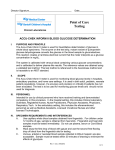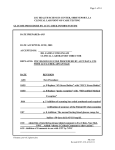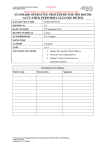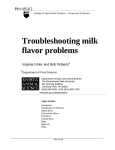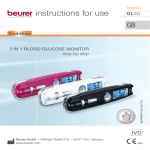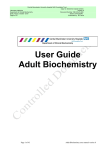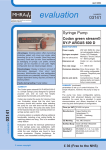Download Roche ACCU-CHEK Inform II User`s guide
Transcript
NORTHERN ARIZONA HEALTHCARE ACCU-CHEK Inform II Competency 2013 Sponsored by the Education Department DIRECTIONS FOR COMPLETING THE 2013 ACCU-CHEK INFORM II COMPETENCY There is one module for all sites. This module contains the ACCU-CHEK INFORM II policy for VVMC and FMC. Please be sure to read the policy for the facility where you will be completing your clinicals. You are responsible for understanding the information for your site. 1. Review the information presented in the policy for the facility where you will be completing your clinicals. 2. Complete the Post-Test and use the Answer Sheet provided to record your responses to the Post-Test. Print out the answer sheet and sign the statement showing that you have read the Guidelines of Practice for Point-of-Care ACCU-CHEK Inform II Blood Glucose Monitoring System Policy. You should give this answer sheet to your instructor. A minimum score of 84% must be attained for successful completion of the module. 3. You should also print out the Hands-On Competency check-list for the facility where you will be completing your clinicals. This will be completed with your instructor and handed in to the hospital. Number: 200.02 NURSING Page 1 of 7 GUIDELINES OF PRACTICE POINT OF CARE ACCU-CHEK INFORM ll BLOOD GLUCOSE MONITORING SYSTEM POLICY The ACCU-CHEK Inform II system quantitatively measures glucose in whole blood. It is used to monitor and treat abnormal glucose levels. This test is definitive for glucose levels but requires laboratory verification of any result outside of the meter’s reportable range as outlined in the procedure below. Only certified or licensed personnel that have successfully completed training on the meter at VVMC can perform this test. Point of care glucose monitoring must be done on Verde Valley Medical Center’s ACCU-CHEK Inform ll meters. PROCEDURE a. Normal Ranges a. 12 years and up: 70- 110 mg/dL b. 6 months to 12 years pediatric range: 60-115 mg/dL c. 0 to 6 months: 40-125 mg/dL d. Pregnancy: 60-110 mg/dL b. Critical Ranges a. 6 months to adults: <60 mg/dL and >450 mg/dL b. 0-6 months: <40 mg/dL and >200 mg/dL c. Reportable Ranges a. 30-500 mg/dL. b. Outside this range needs a laboratory verification sample. d. Specimen Collection and Handling a. The following fresh whole blood sample types may be used: i. Venous whole blood ii. Arterial whole blood iii. Capillary (non-neonate fingerstick and neonate heelstick) whole blood b. The following anticoagulants are acceptable (do not use any other anticoagulants for meter testing): i. Lithium or Sodium Heparin; EDTA c. Sufficient sample size is required for accurate results. e. Safety and Maintenance a. It is important to keep the meters clean and disinfected with an approved germicidal wipe. b. The ACCU-CHEK Inform ll meter should be cleaned after each patient test and every twenty four hours if/when the quality control is done. c. Care should be taken not to get any liquid into the ports at the bottom and top of the meter as this can damage the meter d. The cleaning will be documented electronically in the meter. e. Gloves should always be worn during testing events, hand hygiene performed and gloves changed between patients, according to Standard Precautions. f. Only auto-disabling single-use fingerstick devices are used for assisting monitoring of blood glucose. g. Base Unit and Accessory box cleaning and disinfecting - Base units are cleaned and disinfected with an approved germicidal wipe. h. Cleaning and disinfecting are companion procedures that are generally performed together at the same time. i. Do not clean or disinfect the meter while performing any type of test. j. Do not allow pooling of liquid on the touchscreen. k. Do not spray anything onto the meter or base unit. l. Do not immerse the meter or base unit in liquid. Page 2 of 7 200.02 Point of Care ACCU-CHEK Inform ll Blood Glucose Monitoring System m. Do not get liquid into the strip port! If liquid does get into the test strip port, immediately dry the components with a dry cloth or gauze pad. If solution is allowed to collect in any meter opening, severe damage to the system can occur. If you suspect that moisture may have entered the strip, perform glucose control testing. n. Do not wipe the electrical connectors on the back of the base unit. o. Do not use any cleaning and disinfecting product other than that which is recommended by the manufacturer, identified in this procedure and provided through normal procurement policies and procedures. f. Quality Control Testing a. Two levels of quality control material (Low and High) with known values must be performed every use day. b. If a facility is closed quality control will be done when the facility opens, prior to testing of the first patient. c. Results of both levels of quality control must be within the acceptable ranges before patient testing is done. d. Failure to successfully run quality control within the 24 hour window will result in the ACCU-CHEK Inform ll locking out all patient testing. e. Quality control must also be performed in the following circumstances: i. When a new vial of test strips is opened. ii. If the cap has been left off a vial of test strips. iii. If the meter has been dropped. iv. When questioning patient results or the performance of the meter. g. Procedure for Quality Control Testing a. Turn the meter on by pressing the ON/OFF button located below the center of the touch screen. b. Enter the operator ID by means of scanning the barcode on the identification band. NOTE: If the operator ID you enter is not accepted, attempt to re-enter it. If it is still rejected, contact the laboratory. DO NOT attempt to perform tests under another operator’s ID. c. From the Main Menu, touch Control Test. d. Select the level of control that you wish to test. e. Confirm that the meter is coded (calibrated) to the same test strip code that is printed on the test strip vial by scanning the test strip vial’s barcode. Contact the laboratory if unable to confirm the correct test strip code. f. The meter will display a picture of a test strip with a downward flashing arrow on the meter indicating that you are ready to insert a test strip into the meter. Remove a test strip from the vial and immediately recap the vial. Insert the test strip into the meter in the direction of the arrows and with the “ACCU-CHEK” lettering facing upward. The meter will display a flashing drop above the test strip icon when the test strip is properly inserted indicating that you are ready to apply control solution. g. Apply control solution to the front edge of the test strip. The solution will fill the yellow sample chamber by capillary action. Do not apply sample to the top of the test strip. Once sufficient sample has been detected, the measurement begins. An hourglass icon indicates that the measurement is in progress. You will get an error message if the sample is insufficient. If this occurs, you will need to repeat the test. h. The measurement is complete when the result is displayed on the meter screen. See the “Interpretation of Results” and “Troubleshooting” sections below for guidance on what to do if your result is “Fail” or shows an “out of range” message associated with the result. i. Remove the test strip and dispose of it in plain trash. j. Touch the comment button ( ) to enter an appropriate comment(s) as required in the “General Policies” section of this manual. k. Touch the button to confirm the result and send the result from the meter wirelessly or place the meter in the base unit to send the result and record the result into the electronic data management system. The base unit also charges the meter. Page 3 of 7 200.02 Point of Care ACCU-CHEK Inform ll Blood Glucose Monitoring System h. Interpretation of Quality Control Results a. Results are displayed on the screen as a number. Any result that shows an “out of range” message or “Fail” is an indication that the system may not be performing correctly for patient testing. b. Patient testing may not be performed if quality control testing results are not within acceptable limits and the meter will not display the patient testing option if scheduled quality control results exceed acceptable limits. 9. Special considerations for Patient Testing a. Hematocrit should be between 10–65 %. b. Lipemic samples (triglycerides) in excess of 1800 mg/dL may produce elevated results. c. Blood concentrations of galactose >15 mg/dL will cause overestimation of blood glucose results. d. Intravenous administration of ascorbic acid which results in blood concentrations of ascorbic acid >3 mg/dL will cause overestimation of blood glucose results. e. If peripheral circulation is impaired, collection of capillary blood from the approved sample sites is not advised as the results might not be a true reflection of the physiological blood glucose level. This may apply in the following circumstances: severe dehydration as a result of diabetic ketoacidosis or due to hyperglycemic hyperosmolar non-ketotic syndrome, hypotension, shock, decompensated heart failure NYHA Class IV, or peripheral arterial occlusive disease. f. Hematocrit—the acceptable range for the ACCU-CHEK INFORM ll test strips is 20-65% for values below 200 mg/dL and 20-55% for values above 200 mg/dL. g. Patients in Isolation 1. The meter can be placed in a plastic bag. 2. A small hole can be punctured in the bag. 3. The strip can be placed in the meter through the hole and the meter programmed as usual. 4. After the testing is done the plastic bag is discarded and the meter will be wiped down. 10. Procedure for Patient Testing a. Wash hands and don personal protective equipment (gloves, gowns, etc.) as required by infection control and isolation policies and procedures. b. Assemble the finger-stick equipment, the meter, and the test strips at the patient bedside. c. Identify the patient by armband and explain the procedure. d. Wash and dry patient’s hands/heel with soap and water before obtaining a blood sample. Alcohol wipes are not recommended for use. e. Turn on the meter. f. Scan your operator barcode or enter your 5 digit Lawson ID. You must enter a leading zero if you have a 4 digit Lawson number. If your ID is not on record in the laboratory you will be locked out of the instrument. NOTE: If the operator ID you enter is not accepted, attempt to re-enter it. If it is still rejected, contact your supervisor or Point of Care Coordinator. DO NOT attempt to perform tests under another operator’s ID. g. From the Main Menu, touch Patient Test. h. Scan the patient’s financial number from the bar-coded wristband for the patient ID. i. In any situation where a patient has not been registered, the number 0911911 should be used as the patient identification number. ii. A custom comment should be entered in the ACCU-Check Inform ll system with the patient’s name at the time of testing. This will allow for charting and billing when a financial number is assigned in the future. iii. In certain situations, an employee may need to have a glucose test done. If this occurs, the number 0123456 should be used. This will not be documented as a patient test. i. Confirm that the meter is coded (calibrated) to the same test strip code that is printed on the test strip vial by scanning the test strip vial. Contact the laboratory if you are unable to confirm the correct test strip code. j. You will now see a picture of a test strip with a downward flashing arrow on the screen indicating that you are ready to insert a test strip into the meter. k. Remove a test strip from the vial and immediately recap the vial. Insert the test strip into the meter in the direction of the arrows and with the “ACCU-CHEK” lettering facing upward. The Page 4 of 7 200.02 Point of Care ACCU-CHEK Inform ll Blood Glucose Monitoring System l. m. n. o. p. meter will display a flashing drop above the test strip icon when the test strip is properly inserted indicating that you are ready to apply a blood sample. Perform the finger stick with the Safe-T-Pro Plus lancet. i. Twist off the purple sterility cap. ii. Set lancet depth at 1.3, 1.8 or 2.3 by turning depth adjuster. iii. Hold lancet against the side of fingertip or heel and activate by pressing the purple trigger button on the lancet. 1. A venous or arterial sample may also be used for testing. a. Use fresh sample from the end of the syringe. b. If the blood is collected in a heparinized or EDTA tube, testing must be completed within 30 minutes of being drawn. 2. Fingerstick or neonate heelstick samples. a. Test immediately as the sample is collected. 3. Venous, arterial or line draw samples. a. Test as soon as possible and no later than 30 minutes following collection. Be sure they are well mixed and that line draw samples have been thoroughly cleared of line fluids. Do not allow bubbles to enter the test strip-sampling chamber. Apply blood to the front edge of the test strip. The sample will fill the yellow sample chamber by capillary action. Do not apply sample to the top of the test strip. Do not apply blood or control solution to the test strip before inserting it into the meter. If a result appears before applying blood or control solution, do not act on that result. Once sufficient sample has been detected, the measurement begins. An hourglass icon indicates that the measurement is in progress. After the sample has been obtained, apply gentle pressure to the puncture with a clean gauze square on the site for several minutes. If the patient is conscious and capable, enlist the patient’s assistance with applying pressure. The measurement is complete when the result is displayed on the screen. Depending upon how high or low the result is, it may appear in a numeric or non-numeric format. See Interpretation of Results section below for interpretation of each result format. Remove the test strip and dispose of it in plain trash. q. Touch to enter up to three appropriate comment(s) as required in the “General Policies” section of this manual. r. Touch the button to confirm the result and send the result from the meter wirelessly or place the meter in the base unit to send the result and record the result into the electronic data management system. The base unit also charges the meter. s. Documentation of the result in the patient’s electronic medical record occurs automatically, as long as the patient’s FIN number is entered correctly. t. Follow up on any results that exceed critical or reportable limits according to policy. u. Clean and disinfect as necessary following your hospital’s policy. v. Document cleaning electronically in the meter. w. Discard the strip in the normal waste and discard the lancet in a sharps container. x. The meter should always be placed in the docking station when not in use. This will serve to charge the battery. 11. Interpretation of Results: a. If the glucose value is out of the normal low range <70 mg/dL (adult) or <40 mg/dl (0-6 months) treat per the hypoglycemia guideline of care. b. If the glucose value is >180 mg/dL treat per licensed medical provider orders. c. If the value falls outside of critical range (<60 or >450) or (<40 or >200 in the NICU) the meter will prompt an action comment requiring the operator to contact the patient care provider. i. The date, time, name of person contacted must be documented in the computer in the significant events form including documentation that read back verify (RBV) was done. d. If the glucose is outside of the ACCU-CHEK Inform ll reportable range (<30 or >500), the result is flagged with RR LO or RR HI. i. The meter will prompt for an action comment requiring the operator to contact the patient care provider. Page 5 of 7 200.02 Point of Care ACCU-CHEK Inform ll Blood Glucose Monitoring System ii. iii. a. The date, time, name of person contacted must be documented in the computer in the significant events form including documentation that read back verify (RBV) was done. In addition, the operator should send a specimen to the laboratory for further quantification. The operator should always follow the protocol for hypoglycemia or hyperglycemia that is in place for the patient type. The operator should not wait for the lab confirmation before starting treatment. 12. Documentation a. A licensed medical provider must order all patient testing. b. Glucose results are documented in Powerchart i. Labor and postpartum patients: ACCU-CHEK INFORM LL Inform II results must be charted under "Maternal Vital Signs” in QS. ii. Well newborns in QS: ACCU-CHEK INFORM LL Inform II results must be charted on the newborn flow sheet under “glucose.” c. If patients choose to recheck results with their own glucose meter, these results cannot be used for diagnostic purposes or be documented in the patient’s medical record. d. If a patient is on an insulin pump, it may be used by the patient if the licensed medical provider writes an order for the pump to be used. In this instance the patient’s own glucose meter may be used for glucose testing and insulin bolusing via the patient’s insulin pump. e. Once results are verified the test will automatically charge in computer. f. If the value is outside for the reportable range (<30 or >500), the value entered in computer will be <30 or >500 with a comment added to indicate the actions taken. g. The glucose value of the patient will be stored in the meter and may be retrieved at a later date. h. Whenever the patient result obtained by the ACCU-CHEK Inform ll does not appear to fit the clinical picture repeat the QC and patient specimen. A. You must use the comment “Repeat will not post” on the repeat test. The patient will not be charged for two tests. Only the repeat test will chart. 13. Troubleshooting a. Troubleshooting and technical assistance with the ACCU-CHEK Inform ll is handled by the Point of Care Coordinator (POCC), the Education office, the CRC, superuser, or the superuser on the unit that is responsible for point-of-care glucose testing. c. Document the problem with the red “out of service” tags attached to the meter and bring the meter to the Laboratory. d. Loaner meters are available. E. Help with corrective action is available from the laboratory, in the ACCU-Check Inform ll manual, and within the meter using the “Comment Codes”. 13. Storage of Testing Materials a. Test strips should be stored at room temperature from 36-86°F. b. Unopened test strips are good until the expiration date printed on the label. c. When you take a test strip out of the container, put the cap back on tightly immediately. D. Control material is good 90 days after opened if kept at 39-86°F (4-30°C). 14. Supplies a. Strips and auto-disabling single use fingerstick lancets are stocked in Supply Chain Management and stored in the PYXIS.. b. Do not use the test strips if there is loose desiccant in the test strip vial. c. Controls will be kept in the Laboratory and replaced every three months by the POCC. 15. Training and Proficiency a. New operators need to show proficiency initially, at six months and yearly thereafter. This will be incorporated initially at orientation, at six months with the assistance of superusers and at the annual nursing competency review. b. Glucose proficiency testing, a CAP requirement, will be performed according to the scheduled distribution. c. The testing material, directions and data sheets will be provided by the laboratory. Page 6 of 7 200.02 Point of Care ACCU-CHEK Inform ll Blood Glucose Monitoring System D. The use of another person’s ID in the ACCU-CHEK Inform ll meter is considered falsification of a document and may be subject to disciplinary action. 16. Notes a. In any situation where a patient has not been registered, the number 0911911 should be used as the patient identification number. A custom comment should be entered in the ACCU-Check with the patient’s name at the time of testing. This will allow for charting and billing when a financial number is assigned in the future. b. In special situations, an employee may need to have a glucose test done. If this occurs, the number 0123456 should be used. This will not be documented as a patient test. c. You may get an error code if: Strip is under filled “Type bad dose” Strip defective or previously used, glucose is <10 or end user did not wait for drop symbol to appear before applying sample to the test strip -“Strip Defect Error” 17. Reporting Results a. Data is transferred from the meter into Cerner as follows: i. Wireless Data Transfer: Results will automatically transfer wirelessly into Cerner if a wireless connection is currently available upon completion of a test. A wireless connection is activated when the testing operator touches upon completing a test. An available wireless connection is confirmed by the presence of at the bottom of the screen. If is not present, a wireless connection is not currently available. If a wireless connection is not currently available the meter will automatically send results as soon as a wireless connection is established. The meter will connect to Cerner every 10 minutes and transfer new data when a wireless connection is available even if the meter is powered off. This connection gives the meter the most up to date settings and ADT information when available. ii. Wired Data Transfer: Results are transferred into Cerner by placing the meter into a base unit that is connected to the hospital network through an RJ45 connection connected to the hospital network). When properly docked the meter will automatically transfer test results. The following series of screen displays will appear to confirm that data transfer is occurring: 1. “Connecting,” (meter is establishing connection) 2. “Transferring,” (meter is transferring information) 3. “Idle” (meter has finished communications and is ready to use.) The meter can be removed and used at any time during the transfer of information. Any information not completed will be transferred the next time the meter is docked. When properly docked the meter will communicate every 10 minutes even if the meter is off. This connection gives the meter the most up to date settings and ADT information when available. This transfer can occur also when a wireless meter is docked in a connected base unit. REFERENCES: ACCU-CHEK INFORM LL Inform II User’s Guide. Retrieved from: www.poc.roche.com and www.accucheckinformii.com websites. © 2012-2013, Roche Diagnostics. All rights reserved. Clinical Laboratory Improvement Act of 1988 (CLIA’88) Standards. College of American Pathologists (CAP) Point-of-Care testing checklist. (9/25/2012). McClatchey, Kenneth, ed. (2002) Clinical Laboratory Medicine Second Edition, Philadelphia: Lippincott, Williams, & Wilkins The Diabetes Educator, Vol 31, No. 6, 849-857 (2005) Page 7 of 7 200.02 Point of Care ACCU-CHEK Inform ll Blood Glucose Monitoring System Prepared by/Title/Date: D. Danielson, MT (ASCP), 7/12 Karen McMullin, Director, 7/12, 4/13 Approved by/Title/Date: Susanne Maiden, CNO/VP, 6/13 Committee Approval/Date: Policy & Procedure: 10/06, 5/18/07 Nursing Practice: 8/25/10 GOP: 9/21/10, 7/17/12, 4/16/13, 6/18/13 Dates Reviewed/Revised: 12/99, 11/00, 12/01, 10/03, 12/05, 10/06, 5/07, 10/07, 7/2010 7/2012, 2/2013, 4/13 NUMBER: HP 300-121 Page 1 of 5 HOSPITAL GUIDELINES OF PRACTICE EFFECTIVE DATE: June 12, 1991 TITLE: ACCU-CHECK INFORM II BLOOD GLUCOSE MONITORING SYSTEM PRINCIPLE The ACCU-CHEK Inform II system quantitatively measures glucose in whole blood. The enzyme on the test strip, mutant variant of quinoprotein glucose dehydrogenase from Acinetobacter calcoaceticus, recombinant in E. coli, converts the glucose in the blood sample to gluconolactone. This reaction creates a harmless electrical DC current that the meter interprets for a glucose result. The sample and environmental conditions are also evaluated using a small AC signal. The system is calibrated with venous blood containing various glucose concentrations and is calibrated to deliver plasma-like results. The reference values are obtained using a validated test method. This test method is referenced to the hexokinase method and is traceable to an NIST standard. SPECIMEN Proper blood sample collection is an essential and integral part of bedside blood glucose testing. Acceptable Samples 1. The following fresh whole blood sample types may be used (all line draws must be used within 30 minutes of collection): a. Venous whole blood b. Arterial whole blood c. Capillary (non-neonate finger stick and neonate heel stick) whole blood (test immediately) 2. The following anticoagulants are acceptable (do not use any other anticoagulants for meter testing): a. Lithium or Sodium Heparin; EDTA 3. Refer to Mosby’s Nursing Skills for detailed instructions on how to perform a finger or heel stick. MATERIALS Accu-Chek Inform II meter Accu-Check Inform II glucose strips Accu-Chek Inform II Quality Control solutions Accu-Chek Inform II Linearity Kit Accu-Check Inform II base unit Lancet devices Gloves Sharps container Alcohol wipe REAGENT STORAGE, HANDLING, AND STABILITY Meters, system components and reagents are stored, maintained and handled according to manufacturer’s instructions and in compliance with all established safety and infection control policies and regulatory guidelines. Test Strip Storage and Handling Use the test strips at temperatures between 61-95°F (16-35°C) and between 10-80% relative humidity. Store the test strips at temperatures between 36-86°F (2-30°C). Do not freeze. Store unused test strips in the original container with the cap closed. Do not remove test strips from the test strip container and put them into another container such as a plastic bag or pocket, etc., (to protect from humidity). Use the test strip immediately after removing it from the container. Discard the test strips that are past the expiration date printed on the test strip container. If the expiration date is missing or illegible, do not use the test strips. Do not apply blood or control solution to the test strip before inserting it into the meter. If a result appears before applying blood or control solution, do not act on that result. APPROVED BY/TITLE: DATE REVIEWED: DATE REVISED: 06/26/13 HP 300-121 Page 2 of 5 Cleaning and Disinfecting the ACCU-CHEK Inform II System Components Meter and Base Unit Cleaning and Disinfecting: Cleaning and disinfecting the exterior surface of the meter with either Clorox Bleach Wipes is, at minimum, recommended daily for dedicated patient devices. Meters used with multiple patients may require more frequent cleaning and disinfecting. NOTE: Follow all facility safety and infection control policies when handling, cleaning and disinfecting ACCU-CHEK Inform II meters. QUALITY CONTROL Quality control testing is performed as a primary means of ensuring ongoing proper performance of the ACCU-CHEK Inform II system. Low and high quality control testing is performed on the following occasions: 1. Every 24 hour period of patient testing. 2. When a new test strip vial is opened and placed into service. 3. With unexpected patient results of any kind. 4. Acceptable quality control results are defined as results that are within manufacturer’s posted limits. 5. Quality control testing results must be acceptable prior to performing patient testing, according to the Interpretation of Results section of the procedure below. Procedure 1. Turn on the ACCU-CHEK Inform II meter. 2. Enter the operator ID by means of scanning the barcode on the identification band. NOTE: If the operator ID you enter is not accepted, attempt to re-enter it. If it is still rejected, contact the laboratory. DO NOT attempt to perform tests under another operator’s ID. 3. From the Main Menu, touch Control Test. 4. Select the level of control that you wish to test. 5. Confirm that the meter is coded (calibrated) to the same test strip code that is printed on the test strip vial by scanning the test strip vial’s barcode. Contact the laboratory if unable to confirm the correct test strip code. 6. The meter will display a picture of a test strip with a downward flashing arrow on the meter indicating that you are ready to insert a test strip into the meter. Remove a test strip from the vial and immediately recap the vial. Insert the test strip into the meter in the direction of the arrows and with the “ACCU-CHEK” lettering facing upward. The meter will display a flashing drop above the test strip icon when the test strip is properly inserted indicating that you are ready to apply control solution. 7. Apply control solution to the front edge of the test strip. The solution will fill the yellow sample chamber by capillary action. Do not apply sample to the top of the test strip. Once sufficient sample has been detected, the measurement begins. An hourglass icon indicates that the measurement is in progress. You will get an error message if the sample is insufficient. If this occurs, you will need to repeat the test. 8. The measurement is complete when the result is displayed on the meter screen. See the “Interpretation of Results” and “Troubleshooting” sections below for guidance on what to do if your result is “Fail” or shows an “out of range” message associated with the result. 9. Remove the test strip and dispose of it in plain trash. 10. Touch the comment button ( Policies” section of this manual. ) to enter an appropriate comment(s) as required in the “General 11. Touch the button to confirm the result and send the result from the meter wirelessly or place the meter in the base unit to send the result and record the result into the electronic data management system. The base unit also charges the meter. Interpretation of Quality Control Reviewed/Revised 06/26/13 HP 300-121 Page 3 of 5 1. Results are displayed on the screen as a number. Any result that shows an “out of range” message or “Fail” is an indication that the system may not be performing correctly for patient testing. PROCEDURE Patient Testing Procedure 1. Carefully assess the patient for any indication that bedside glucose testing may not be appropriate. Consider the following potential interferences and compromising conditions: Hematocrit should be between 10-65%. Lipemic samples (triglycerides) in excess of 1800 mg/dL may produce elevated results. Blood concentrations of galactose >15 mg/dL will cause overestimation of blood glucose results. Intravenous administration of ascorbic acid which results in blood concentrations of ascorbic acid >3 mg/dL will cause overestimation of blood glucose results. If peripheral circulation is impaired, collection of capillary blood from the approved sample sites is not advised as the results might not be a true reflection of the physiological blood glucose level. This may apply in the following circumstances: severe dehydration as a result of diabetic ketoacidosis or due to hyperglycemic hyperosmolar non-ketotic syndrome, hypotension, shock, decompensated heart failure NYHA Class IV, or peripheral arterial occlusive disease. NOTE: The performance of this system has not been evaluated in the critically ill. 2. Take the meter and testing supplies to the patient location. 3. Wash hands and don personal protective equipment (gloves, gowns, etc.) as required by infection control and isolation policies and procedures. 4. Greet and identify the patient. 5. Explain the procedure to the patient. 6. Turn on the ACCU-CHEK Inform II meter and enter your operator ID by means of scanning the barcode on your identification badge. NOTE: If the operator ID you enter is not accepted, attempt to re-enter it. If it is still rejected, contact your supervisor or Point of Care Coordinator. DO NOT attempt to perform tests under another operator’s ID. 7. From the Main Menu, touch Patient Test. 8. Enter the patient’s FIN number or scan patient’s hospital ID band as the identification in the ACCUCHEK Inform II system. In the event the patient is a trauma and is not registered at the time glucose testing is needed, 0911911 may be used as an alternate patient ID number. 9. Confirm that the meter is coded (calibrated) to the same test strip code that is printed on the test strip vial by scanning the test strip vial. Contact the laboratory if you are unable to confirm the correct test strip code. 10. A picture of a test strip with a downward flashing arrow on the screen indicates a test strip may be inserted into the meter. 11. Remove a test strip from the vial and immediately recap the vial. Insert the test strip into the meter in the direction of the arrows and with the “ACCU-CHEK” lettering facing upward. The meter will display a flashing drop above the test strip icon when the test strip is properly inserted indicating that you are ready to apply a blood sample. 12. Collect an acceptable blood sample according to your facility’s established procedures. a. If using a capillary sample, wipe the first drop away when testing capillary samples, this is advantageous because it ensures that the cleansing agent is dry, it stimulates blood flow and clears interstitial fluid from the sample. 13. Apply blood to the front edge of the test strip. The sample will fill the yellow sample chamber by capillary action. Do not apply sample to the top of the test strip. 14. Once sufficient sample has been detected, the measurement begins. An hourglass icon indicates that the measurement is in progress. Reviewed/Revised 06/26/13 HP 300-121 Page 4 of 5 15. After the sample has been obtained, apply gentle pressure to the puncture with a clean gauze square or cotton ball site for several minutes. 16. The measurement is complete when the result is displayed on the screen. Depending upon how high or low the result is, it may appear in a numeric or non-numeric format. See Reporting Results section below for interpretation of each result format. 17. Remove the test strip and dispose of it in plain trash. 18. Touch to enter up to three appropriate comment(s) as required in the “General Policies” section of this manual. 19. Touch the button to confirm the result and send the result from the meter wirelessly or place the meter in the base unit to send the result and record the result into the electronic data management system. The base unit also charges the meter. 20. Documentation of the result in the patient’s electronic medical record occurs automatically, as long as the patient’s FIN number is entered correctly. 21. Follow up on any results that exceed critical or reportable limits according to policy. 22. Clean and disinfect as necessary with Clorox wipes. 23. Error messages: If the error message “Strip Defect Error” appears on the display, the test strip may be defective or the blood glucose result may be extremely low and below the meter’s measurement range. Refer to the test strip package insert, perform a quality control test using a new test strip, review proper testing procedure, and repeat the blood glucose test, or follow your facility’s testing policy. If the meter displays “Type Bad Dose,” there may be insufficient amount of blood on the test strip. Repeat the test using a new test strip, ensuring proper sample application, or refer to the test strip package insert. Guidance for Interpreting On-Screen Message and Error Codes: All error messages displayed by the system have a letter identifying the message type, a number and a description of the error to help the operator take action to resolve the problem. The different message types are in the table below. E Identifies the notification as an Error. operator that an error has occurred. The information notifies the W Identifies the notification as a Warning. The information does not block the operator from continuing, but rather gives the operator information that may suggest an alternate workflow is required. I Identifies the notification as Informational only. Informational notifications present the operator with contextual information, and allow the operator to proceed after confirming the notification. D Identifies a Decision point. Decision notifications provide the operator with a choice based on contextual information. Linearity Testing Procedure Linearity testing, also known as calibration verification, is a means of testing the ACCU-CHEK Inform II system’s ability to give correct readings through a broad range of glucose levels. It is used as a periodic check on system performance. Linearity testing is performed on 10% of meters during new instrument implementation, then on all subsequent meters or as part of troubleshooting related to questionable meter performance. Proficiency Testing Procedure Participation in proficiency testing is part of the quality assurance program to ensure proper on-going performance of the ACCU-CHEK Inform II system and the competence of staff performing tests. At least 10% of meters are tested during each proficiency cycle by staff routinely using the device. Results are submitted to CAP without consulting with any other survey subscribers. The survey report is reviewed by Reviewed/Revised 06/26/13 HP 300-121 Page 5 of 5 the Laboratory Director/Medical Director or Designee Appropriate corrective action is taken in the event of survey failures. REPORTING RESULTS Data is transferred from the meter into Cerner as follows: 1. Wireless Data Transfer: Results will automatically transfer wirelessly into Cerner if a wireless connection is currently available upon completion of a test. A wireless connection is activated when the testing operator touches upon completing a test. The meter will connect to Cerner every 10 minutes and transfer new data when a wireless connection is available even if the meter is powered off. This connection gives the meter the most up to date settings and ADT information when available. 2. Wired Data Transfer: Results are transferred into Cerner by placing the meter into a base unit that is connected to the hospital network through an RJ45 connection connected to the hospital network). When properly docked the meter will automatically transfer test results. The following series of screen displays will appear to confirm that data transfer is occurring: Critical limits for adult patient tests are ≤45 mg/dL and ≥450 mg/dL and for newborns, ≤30 mg/dL and ≥300 mg/dL. Patient test results that exceed critical limits must be called to the patient’s provider and then documented in the patient electronic medical records. Reportable limits for patient testing are ≤30 mg/dL and ≥500 mg/dL. Results that exceed the reportable limits of the system will be displayed as RR HI/RR LO or HI/LO, the measurement range default. Patient test results that exceed reportable limits must have follow-up testing performed in the laboratory. ATTACHMENTS N/A REFERENCES ACCU-CHEK Inform II User’s Guide. Retrieved from: www.poc.roche.com and www.accu-checkinformii.com websites, © 2012-2013, Roche Diagnostics. All rights reserved. Mosby’s Nursing Skills, 2013. Blood Glucose Monitoring. Retrieved from http://mns.elsevierperformancemanager.com/NursingSkills/ContentPlayer/Skill ContentPlayerIFrame.aspx?KeyId=430&Id=GN_43_12&Section=1&bcp=Sear chOp~0~glucose~False&IsConnect=False Blood Glucose Monitoring (Pediatric). Retrieved from http://mns.elsevierperformancemanager.com/NursingSkills/ContentPlayer/Skill ContentPlayerIFrame.aspx?KeyId=855&Id=CCP_133&Section=1&bcp=Searc hOp~0~glucose~False&IsConnect=False Heel Stick (Neonatal). Retrieved from http://mns.elsevierperformancemanager.com/NursingSkills/ContentPlayer/Skill ContentPlayerIFrame.aspx?KeyId=1233&Id=NN_003&Section=1&bcp=Searc hOp~0~heelstick~False&IsConnect=False Reviewed/Revised 06/26/13 Name:_______________________________ Lawson #:_____________ Date:________ ACCU-CHEK INFORM II TEST COMPETENCY Please read the Guidelines of Practice for Point-of-Care ACCU-CHEK Inform II Blood Glucose Monitoring System and answer the following questions: Questions: 1. When does a specimen need to be sent to the lab for verification? a. When the meter reads RR HI b. When the meter reads RR LO c. When results are questionable d. All of the above e. None of the above 2. The measurement (testing) will start when the appropriate amount of sample is applied to the Accu-chek Inform ll test strip. If it is not the correct amount, it will give an error code. a. True b. False 3. After applying the sample to the test strip and the measurement begins - an “error” message occur - this means: a. The sample is insufficient. b. The strip was previously used. c. The glucose is less than 10. d. Sample was applied before the drop symbol appeared on the screen. e. All of the above 4. What number is used as the patient identifier? a. The patient’s Social Security number b. The patient’s Medical Record number c. The patient’s financial (FIN) number d. The operator’s Lawson ID number 5. In what situation is it appropriate to use 0911911 as the patient identifier? a. The patient comes in as a trauma and isn’t registered yet b. You are a diabetic and wish to test yourself c. You are having a busy night d. a and b 6. How long are quality control solutions good after opening? a. 15 days b. 30 days c. 45 days d. 90 days 7. If the meter is not working properly you should a. Try to reset the meter by unplugging the dock system b. Place a red “out of service” tag on the meter and take the meter to the lab. c. Borrow a meter from another unit d. Submit a “work order” to BIOMED 8. If the meter reads patient results outside the Critical or reportable ranges a. Notify patient care provider and then document in Cerner. b. Do nothing; patients have critical glucose results all the time c. Test the patients five more times to be sure d. None of the above 9. What is true of test strip handling? a. b. c. d. Test strips do not have an expiration date Remove the test strip from the vial and immediately recap the vial. Unopened test strips are kept in the lab Opened vials of test strips are stored in the refrigerator to limit exposure to humidity 10. You confirm the meter is coded (calibrated) by scanning the test strip vial. a. True b. False 11. The meter should be cleaned when: a. The meter is visibly soiled b. At least daily c. After running a test on a patient in isolation d. After each patient use e. All of the above 12. If the operator’s ID is not accepted, the operator would: a. Call the laboratory b. Attempt to re-enter his/her ID c. Borrow another operators badge d. All of the above e. a and b 13. You should touch and hold the drop of blood to the front edge of the Accu-chek Inform ll test strip. a. True b. False 14. Only capillary whole blood samples should be used when testing the Accu-chek Inform ll meter and the Accu-chek Inform ll test strips. a. True b. False ANSWER SHEET FOR 2013 ACCU-CHEK INFORM II TEST COMPETENCY Name________________________________ Lawson ID #________________ Date_________________________________ School/Facility Name_______________________Score___________________ Directions: Circle the best answer. 1. a b c d e 2. a b 3. a b c d e 4. a b c d 5. a b c d 6. a b c d 7. a b c d 8. a b c d 9. a b c d The undersigned certifies as follows: 10. a b 11. a b c d e 12. a b c d e 13. a b I have read the Guidelines of Practice for Pointof- Care ACCU-CHEK Inform II Blood Glucose Monitoring System Policy. I understand this test in of itself does not test competency. This test in conjunction with a “hands on” demonstration is needed to certify competency and allowing the use of the ACCU-CHEK system. 14. a b Student Signature Date Instructor’s Name: ___________________________________________________ VVMC ACCU-CHEK Inform II Skills Checklist Critical Elements 1. Demonstrates knowledge of Accu-chek Inform II meter and the dock station Demonstrates knowledge of proper equipment used (soap, water, gauze pads) Demonstrates knowledge and importance of proper lot number verification) Demonstrates knowledge of proper test strip application Properly doses the test strip Enters Operator ID and Patient ID according to policy (Scan own badge, and wristband) 2. Understands why meter needs to be docked after use (charges battery) Quality Control States when controls are routinely run (once every 24 hrs—or every use day) States when to discard control solution (at exp. date or 90 days after opening) States what to do when control result fails to fall within the acceptable range (repeat the test and document remedial action with a comment) Demonstrates correct procedure for Hi & Lo solution testing Hospital Critical Limits, Documentation and Follow-up States critical values (<60 or >450 mg/Dl; notify provider of critical results) 0-6 months (<40 or >200 mg/dL 3. Demonstrates importance of comments (notify provider/ or notify RN) and repeat criteria States when venous sample is sent to central laboratory for confirmation (<30 or >500 mg/dL 6 months to Adult) (<30 or>500mg/dL 0-6months) 5. States emergency ID # when patient is unidentified (0911911). Verbalizes how to enter a custom comment (patient’s name) Cleaning States proper infection control and safety practices States cleaning techniques for the meter – wipe ACCU-CHEK Inform II meter with Aseptiwipes States the importance of not getting liquid into the strip port- If liquid does get into the test strip port, immediately dry the components with a dry cloth or gauze pad. State cleaning frequency (after each patient use, at time of quality control, once every 24 hours) States how to document cleaning electronically in the meter States cleaning precautions – After cleaning, wait until the meter is completely dry before docking. Yes No Comment Employee: I have read the Guidelines of Practice for Point of Care Accu-Chek Inform II Blood Glucose Monitoring System. I feel competent to perform above skills. I understand that the use of another person’s ID or a false patient identification in the ACCU-CHECK Inform II meter is considered falsification of a document and may result in disciplinary action. Signature:______________________________________/Lawson No____________Date______________________: Trainers: The above skills have been successfully demonstrated and stated correctly. By signing this competency check list. Signature: ____________________________________ Date: ____________ FMC ACCU-CHEK Inform II Skills Checklist Critical Elements 1. Demonstrates knowledge of Accu-chek Inform II meter and the dock station Demonstrates knowledge of proper equipment used (soap, water, gauze pads) Demonstrates knowledge and importance of proper lot number verification) Demonstrates knowledge of proper test strip application Properly doses the test strip Enters Operator ID and Patient ID according to policy (Scan own badge, and wristband) Yes No Comment Understands why meter needs to be docked after use (charges battery) 2. Quality Control States when controls are routinely run (once every 24 hrs—or every use day) States when to discard control solution (at exp. date or 90 days after opening) States what to do when control result fails to fall within the acceptable range (repeat the test and document remedial action with a comment) Demonstrates correct procedure for Hi & Lo solution testing Hospital Critical Limits, Documentation and Follow-up States critical values (≤45 or ≥450 mg/dL; notify provider of critical results) newborns (≤30 or ≥300 mg/dL 3. Demonstrates importance of comments (notify provider/ or notify RN) and repeat criteria States when venous sample is sent to central laboratory for confirmation (≤30 or ≥500 mg). States emergency ID # when patient is unidentified (0911911). Verbalizes how to enter a custom comment (patient’s name) 5. Cleaning States proper infection control and safety practices States cleaning techniques for the meter – wipe ACCU-CHEK Inform II meter with Chlorox Bleach Wipes States the importance of not getting liquid into the strip port- If liquid does get into the test strip port, immediately dry the components with a dry cloth or gauze pad. State cleaning frequency (after each patient use, at time of quality control, once every 24 hours) States how to document cleaning electronically in the meter States cleaning precautions – After cleaning, wait until the meter is completely dry before docking. Employee: I feel competent to perform above skills. I understand that the use of another person’s ID or a false patient identification in the ACCU-CHECK Inform II meter is considered falsification of a document and may result in disciplinary action. Signature:______________________________________/Lawson No____________Date______________________: Trainers: The above skills have been successfully demonstrated and stated correctly. By signing this competency check list. The employee listed above agrees to take the on-line quiz within 2 days of completion of this skills lab. Signature: ____________________________________ Date: ____________




















